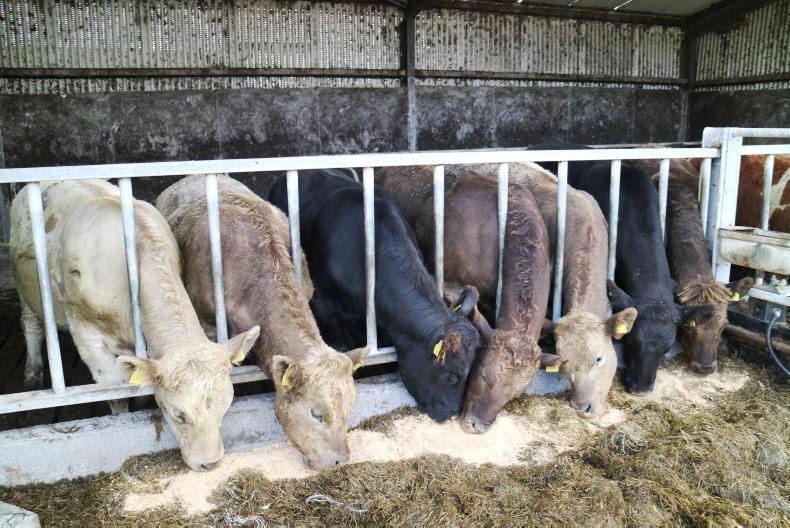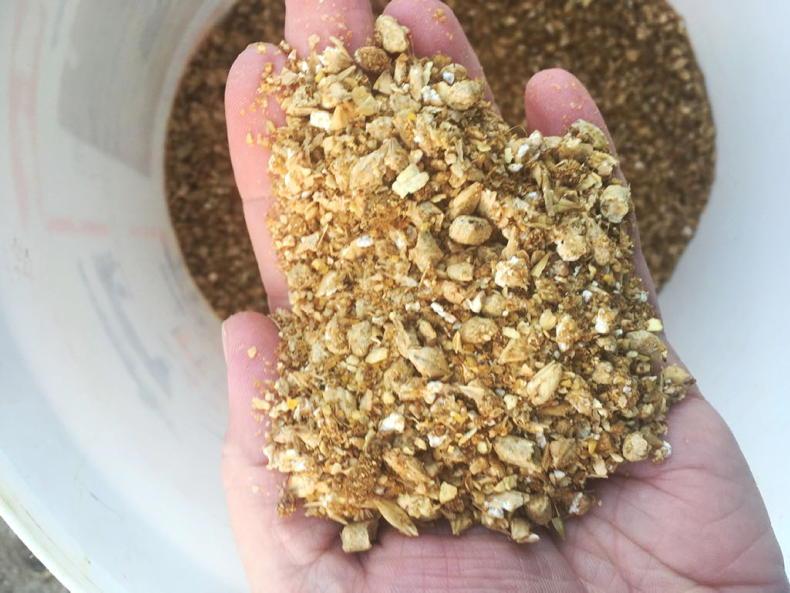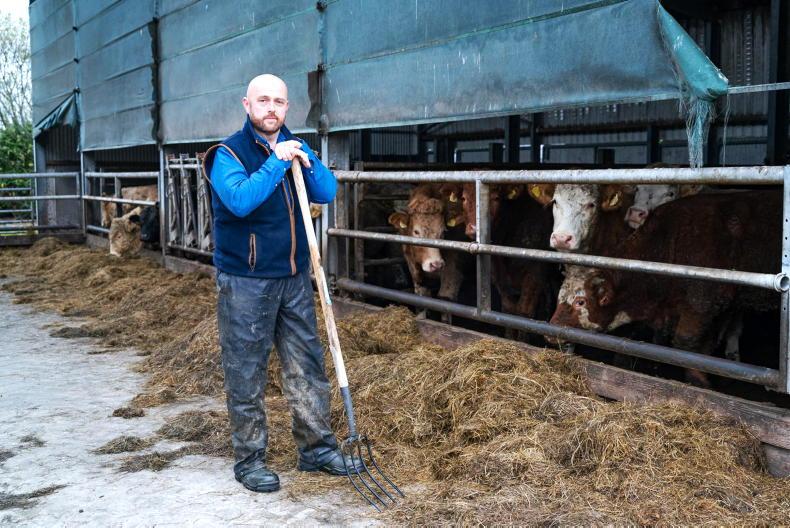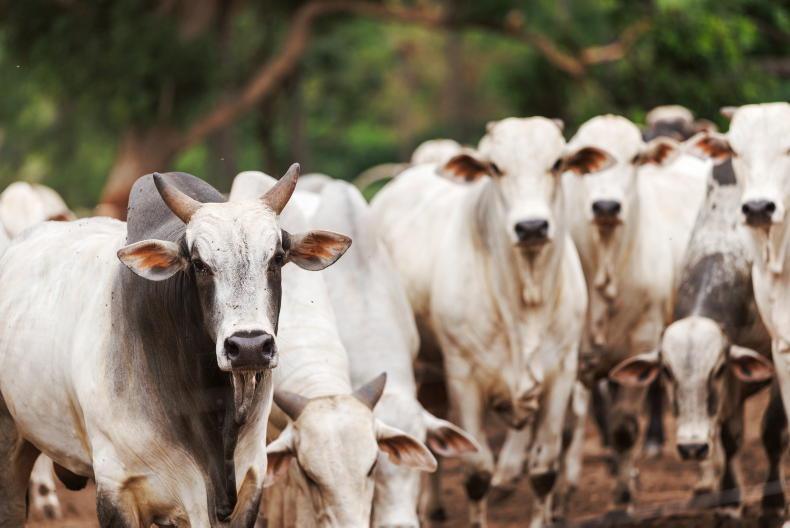When excessive amounts of grain and carbohydrates are fed to ruminants with inadequate fibre in the diet, ruminal acidosis can occur. Ruminal acidosis in cattle can be acute, subacute or chronic. During acute ruminal acidosis, the pH in the rumen drastically drops and remains low for an extended period of time up to a day. If left untreated, acute acidosis can develop into complete metabolic acidosis. Subacute ruminal acidosis (SARA) is regarded as by repeated spells of low rumen pH, but unlike the situation with acute acidosis, the pH recovers after each spell. These spells of low pH typically last for several hours. The long spells are of concern because they negatively affect fibre digestion.
Cause
The main cause of acidosis is an overload of grain. It can occur when livestock are suddenly grain fed without being gradually introduced to the grain or meal previously, and this is known as acute acidosis. It can also occur when livestock get unplanned access to a meal store or silo. Sub-acute ruminal acidosis (SARA) most often occurs when dairy cows are fed very lush grass (usually spring grass) with high levels of carbohydrate, which can have a negative effect on rumen pH. There is very little fibre in such grass, resulting in reduced rumination.
Symptoms
Acute acidosis has pronounced symptoms and typically occurs during the adaptation to high-concentrate diets. It is the type that will leave lasting effects on an animal, if they survive. Symptoms of acute acidosis include:
• Violent diarrhoea. • Abdominal kicking.• Rapid breathing.• Staggering.• Death.Sub-acute acidosis is more difficult to detect and, although the effects on the individual animal will not be as severe as acute acidosis, bouts of SARA typically affect multiple animals in a group and, if undetected, can have huge financial implications as production nosedives. Symptoms include:
• Less than 60% of resting animals in a group ruminating at a given time.• Loose, bubbly dung.• Greater than 10% incidence of laminitis.• Poor intakes and weight gain.• Lethargy.• Increased respiratory rate.• Reduced milk yields, when they should be at their best. In addition, acidosis predisposes animals to other ailments. A build-up of acids in the rumen leads to the formation of inflammatory agents which can travel to the animal’s feet via the bloodstream and cause a lameness, known as laminitis. This can predispose to sole ulcers. A damaged rumen wall can also facilitate the absorption of unwanted bacteria into the bloodstream. These bacteria accumulate in the liver and can cause liver abscesses. Acidosis can also lead to bloating as the viscosity of the fluid in the rumen changes and traps gas, which would otherwise be belched out, as foam. As the animal bloats up, physical pressure is put on the lungs, which can lead to suffocation.
Treatment
Acute acidosis is an emergency, requiring prompt veterinary intervention. Animals may need intravenous fluids. They may need bicarbonate to neutralise the lactic acid. Assuming they recover, they will need probiotics to reseed their rumens with good bacteria. The principles of treatment for SARA are similar, but because it is a dietary issue, it is likely to need group treatment. Fibre needs to be increased in the diet, through hay, baled silage or straw. Appropriate feed additives may be necessary to neutralise the lactic acid in the rumen, and a probiotic to reseed the rumen with good bacteria.
Prevention
It is all about prevention when it comes to acidosis. This can be achieved by introducing high-concentrate rations gradually. Gradual adaptation allows the rumen time to acclimatise to a new diet. For beef cattle, when building up to any type of finishing diet, offer no more than 3kg of meals per head initially. Then, increase meal allowance by 1kg every three days. Delay an increase if animals are slow to consume the meals or if there is any evidence of SARA symptoms. Above 5kg of feeding daily, split feeds in two and continue to increase total daily feed allowance by 1kg every three days. Once animals are consuming 10kg daily, concentrates can be offered ad-lib and feed should never be allowed to run out. Cattle should have access to long fibre (straw/silage) at all times. Long fibre stimulates rumen contractions, which help to prevent acid from accumulating in the stomach.
It also slows down the rate of rumen digestion and promotes both cud chewing and salivation – all of which help to prevent acidic conditions. Water is crucial too and water issues can be a big contributor to below-par performance in finishing situations. Cattle on ad-lib concentrates need to be provided with access to multiple water points with good flow rates and/or large-volume troughs. In the event of a loss of water supply, stop feeding concentrates. When the water supply is restored, reintroduce the concentrates like they were first introduced to the cattle.
When excessive amounts of grain and carbohydrates are fed to ruminants with inadequate fibre in the diet, ruminal acidosis can occur. Ruminal acidosis in cattle can be acute, subacute or chronic. During acute ruminal acidosis, the pH in the rumen drastically drops and remains low for an extended period of time up to a day. If left untreated, acute acidosis can develop into complete metabolic acidosis. Subacute ruminal acidosis (SARA) is regarded as by repeated spells of low rumen pH, but unlike the situation with acute acidosis, the pH recovers after each spell. These spells of low pH typically last for several hours. The long spells are of concern because they negatively affect fibre digestion.
Cause
The main cause of acidosis is an overload of grain. It can occur when livestock are suddenly grain fed without being gradually introduced to the grain or meal previously, and this is known as acute acidosis. It can also occur when livestock get unplanned access to a meal store or silo. Sub-acute ruminal acidosis (SARA) most often occurs when dairy cows are fed very lush grass (usually spring grass) with high levels of carbohydrate, which can have a negative effect on rumen pH. There is very little fibre in such grass, resulting in reduced rumination.
Symptoms
Acute acidosis has pronounced symptoms and typically occurs during the adaptation to high-concentrate diets. It is the type that will leave lasting effects on an animal, if they survive. Symptoms of acute acidosis include:
• Violent diarrhoea. • Abdominal kicking.• Rapid breathing.• Staggering.• Death.Sub-acute acidosis is more difficult to detect and, although the effects on the individual animal will not be as severe as acute acidosis, bouts of SARA typically affect multiple animals in a group and, if undetected, can have huge financial implications as production nosedives. Symptoms include:
• Less than 60% of resting animals in a group ruminating at a given time.• Loose, bubbly dung.• Greater than 10% incidence of laminitis.• Poor intakes and weight gain.• Lethargy.• Increased respiratory rate.• Reduced milk yields, when they should be at their best. In addition, acidosis predisposes animals to other ailments. A build-up of acids in the rumen leads to the formation of inflammatory agents which can travel to the animal’s feet via the bloodstream and cause a lameness, known as laminitis. This can predispose to sole ulcers. A damaged rumen wall can also facilitate the absorption of unwanted bacteria into the bloodstream. These bacteria accumulate in the liver and can cause liver abscesses. Acidosis can also lead to bloating as the viscosity of the fluid in the rumen changes and traps gas, which would otherwise be belched out, as foam. As the animal bloats up, physical pressure is put on the lungs, which can lead to suffocation.
Treatment
Acute acidosis is an emergency, requiring prompt veterinary intervention. Animals may need intravenous fluids. They may need bicarbonate to neutralise the lactic acid. Assuming they recover, they will need probiotics to reseed their rumens with good bacteria. The principles of treatment for SARA are similar, but because it is a dietary issue, it is likely to need group treatment. Fibre needs to be increased in the diet, through hay, baled silage or straw. Appropriate feed additives may be necessary to neutralise the lactic acid in the rumen, and a probiotic to reseed the rumen with good bacteria.
Prevention
It is all about prevention when it comes to acidosis. This can be achieved by introducing high-concentrate rations gradually. Gradual adaptation allows the rumen time to acclimatise to a new diet. For beef cattle, when building up to any type of finishing diet, offer no more than 3kg of meals per head initially. Then, increase meal allowance by 1kg every three days. Delay an increase if animals are slow to consume the meals or if there is any evidence of SARA symptoms. Above 5kg of feeding daily, split feeds in two and continue to increase total daily feed allowance by 1kg every three days. Once animals are consuming 10kg daily, concentrates can be offered ad-lib and feed should never be allowed to run out. Cattle should have access to long fibre (straw/silage) at all times. Long fibre stimulates rumen contractions, which help to prevent acid from accumulating in the stomach.
It also slows down the rate of rumen digestion and promotes both cud chewing and salivation – all of which help to prevent acidic conditions. Water is crucial too and water issues can be a big contributor to below-par performance in finishing situations. Cattle on ad-lib concentrates need to be provided with access to multiple water points with good flow rates and/or large-volume troughs. In the event of a loss of water supply, stop feeding concentrates. When the water supply is restored, reintroduce the concentrates like they were first introduced to the cattle.










SHARING OPTIONS